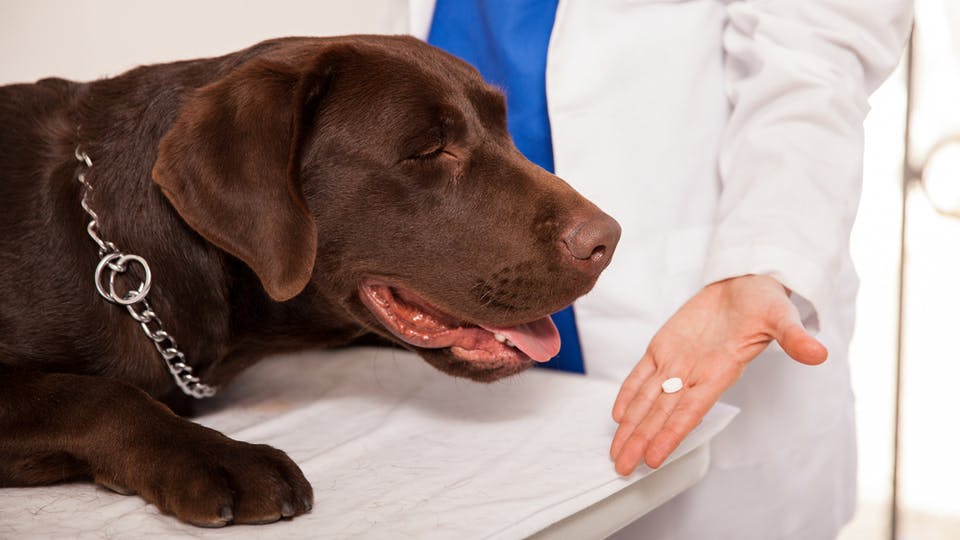Metronidazole, also known as Flagyl, is an antibiotic prescribed by vets to treat inflammatory bowel disease (IBD), diarrhea, and other parasitic and bacterial infections in dogs.
But are there any side effects you should be aware of? And what’s the proper dosage of Metronidazole for your furry pal?
Here is everything you need to know about the uses, side effects, and dosage of metronidazole in canines.
- Uses of Metronidazole for Dogs
- Dosage of Metronidazole for Dogs
- Side Effects of Metronidazole for Dogs
- Diagnosis of Metronidazole Toxicity in Dogs
- Treatment of Metronidazole Toxicity
- Recovery from Metronidazole Toxicity
- Key Takeaways
 (Image source: Dogalize)
(Image source: Dogalize)
Uses of Metronidazole for Dogs
Metronidazole is used primarily as an anti-diarrheal medication for dogs, but it is also prescribed to treat protozoal infections including Balantidium Coli, Giardia, and Trichomonas, as well as anaerobic bacterial pathogens.
Metronidazole can also be prescribed to treat sepsis, dental or oral infections, IBD (inflammatory bowel disease), internal abscesses, and bone infections.
The drug is able to cross the blood-brain barrier, which also makes it useful in treating inflammatory CNS diseases.
Pro tip: Medications prescribed by your vet as a treatment for an accident or illness, including antibiotics, are covered by pet insurance policies. However, you should bear in mind that pet insurance policies don’t cover the treatment for pre-existing conditions. That’s why it is so important to protect your dog as early as possible before an unexpected injury or illness strikes.
Dosage of Metronidazole for Dogs
Never administer medication to your dog before consulting your vet. This drug has extended release in humans, but canines have shorter digestive tracts and might only partially digest the drug. In some cases, like when a dog has a blocked airway or sepsis, the veterinarian might decide to inject the medicine.
Call your vet to get dosage instructions for your pet and to check if Metronidazole is safe for your specific pet. Metronidazole tablets usually come in strengths of 250 mg - 500 mg. The standard dosage for canines will depend on the condition that’s being treated.
If you miss a dose of the drug, make sure to give it as soon as possible. However, if it’s almost time for the next dose, skip the missed one and continue with the regular schedule. Never give your dog two doses at once.
The oral, liquid form of the drug should be kept in the fridge and shaken well before use. Capsules and tablets should be kept in a tightly sealed container at room temperature, away from light and heat.
Side Effects of Metronidazole for Dogs
Metronidazole is considered to be safe for dogs when administered properly and rarely causes side effects. The list of common possible side effects includes:
- Diarrhea
- Nausea and vomiting
- Drooling
- Loss of appetite
- Regurgitation or gagging
- Fatigue or lethargy
- Fever
- Blood in the urine
Less common side effects include:
- Insomnia
- Liver damage
- Low platelet count (thrombocytopenia)
- Irregular or abnormally slow heartbeat
- Dilated pupils
- Seizures
- Tremors
- Stiffness
The drug can also cause neurological symptoms such as :
- Staggering
- Stiffness
- Seizures
- Abnormal eye movements
- Loss of balance and coordination
- Head tilt
- Stumbling or knuckling
- Strange behavior
As with all drugs, there’s a possibility of an allergic reaction that can result in anaphylaxis. "Anaphylaxis in Dogs | VCA Animal Hospital"), a potentially life-threatening condition. Signs of an allergic reaction include rash, hives, rapid heartbeat, difficulty breathing, and swelling.
Puppies and pregnant pups, as well as pups with a history of kidney or liver disease, those who have seizure disorders or from neutropenia, as well as dogs who had an adverse reaction to the drug in the past, shouldn’t take Metronidazole. Be sure to let your vet know if your dog suffers from any of these conditions or is taking any other medications, including vitamins, herbal therapies, or supplements.
Veterinary journals say that most cases of Metronidazole toxicity involve very high doses or chronic use of the drug.
 (Image source: Dog Time)
(Image source: Dog Time)
Diagnosis of Metronidazole Toxicity in Dogs
If you notice any of the above-mentioned symptoms in your dog, take them to the vet and let your vet know if you have given your pup any other drugs.
The vet will perform a physical exam which includes weight, height, body temperature, reflexes, skin and coat condition, respiratory and heart rate, breath sounds, oxygen level, and blood pressure.
Standard tests used for verifying metronidazole toxicity are an MRI and a spinal tap. The latter is done by inserting a thin needle into the spinal cord to collect spinal fluid for analysis. An MRI will be conducted to check for brain hemorrhaging and/or cerebellar degeneration. Your furry friend will be anesthetized for both procedures for safety.
Your vet will also want to do serum analysis and a blood count in order to check for underlying conditions. X-rays, an ultrasound, and a CT scan might also be done for further inspection.
Treatment of Metronidazole Toxicity
If Metronidazole toxicity is confirmed, the medication will be stopped and your dog will receive therapy to treat the symptoms.
The medication your dog receives will depend on the test results and symptoms, but vets usually prescribe diazepam to relieve vestibular dysfunction and shorten the recovery time.
The vet might also prescribe IV fluids along with nutrients and electrolytes as needed, to flush the kidneys and prevent your dog from getting dehydrated.
They will likely suggest your canine companion be hospitalized for at least 24 hours for supplemental treatment and observation. How long your pooch will stay in the hospital will depend on the severity of the symptoms and how well they respond to the therapy.
Pro tip: Pet insurance covers emergencies related to accidents, such as toxic ingestions. It also includes all sorts of services related to accidents, like MRI, X-rays, bloodwork, ultrasounds, medications, hospitalization, and surgery.
Recovery from Metronidazole Toxicity
Recovery from Metronidazole toxicity is long and depends on how much Metronidazole your dog was given (or accidentally ingested), as well as how long they were taking the drug.
The average length of recovery is from 12 to 16 days and, in some cases, it might be as long as 3 weeks.
As they recover, feed your pooch something bland, simple, and nutritious. One great solution is bone broth, which can be served individually or with small amounts of meat and mashed vegetables.
You can also give your pooch prebiotic and probiotic foods to help improve gut health. Foods like kefir, fermented veggies, and yogurt are an excellent source of probiotics, while chicory root, dandelion greens are excellent prebiotic options.
Another option to consider is fasting. Stop feeding your pooch for a short period of time (from 6 to 24 hours) to give their digestive system time to heal and let their gut work out the issues on its own. Once the symptoms start to improve, slowly reintroduce food and water back into their diet.
In most cases, after your four-legged companion receives proper vet care, all the side effects will be reversed and they should have no long-term complications.
Final Thoughts
Metronidazole is an antibiotic that is used in treating many kinds of infections in dogs, like diarrheal disorders, inflammatory bowel disease, dental infections, giardia, etc. Even though there have been some side effects reported in dogs, if your vet prescribes it, then they believe your pup will benefit from the drug.
Talk to your vet about any side effects or complications before administering the drug to your beloved pet.
Key Takeaways
- Your vet may prescribe Metronidazole for dogs to treat gastrointestinal symptoms.
- It's important to watch for the signs of Metronidazole toxicity in dogs with chronic drug use.
- Pet insurance can help offset the cost of veterinary treatment and labratory testing required to protect your pup's health.
